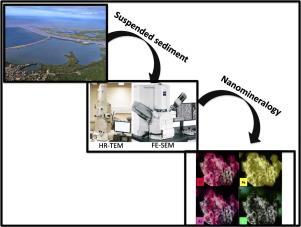Marine Pollution Bulletin ( IF 5.3 ) Pub Date : 2021-04-30 , DOI: 10.1016/j.marpolbul.2021.112405 Luis F.O. Silva , Guilherme L. Dotto , Diana Pinto , Marcos L.S. Oliveira

|
Studies examining nanoparticles (NPs) and hazardous elements (HEs) contained in suspended sediments (SSs) are vital for watershed administration and ecological impact evaluation. The biochemical consequence of titanium-nanoparticles (Ti-NPs) from SSs in Colombia's Magdalena River was examined utilizing an innovative approach involving nanogeochemistry in this study. In general, the toxicity and the human health risk assessment associated with the presence of some Ti-NPs + HEs in SSs from riverine systems need to be determined with a robust analytical procedure. The mode of occurrence of Ti-NPs, total Ti and other elements contained within SSs of the Magdalena River were evaluated through advanced electron microscopy (field emission scanning electron microscope-FE-SEM and high resolution transmission electron microscope-HR-TEM) coupled with an energy dispersive X-ray microanalysis system (EDS); X-Ray Diffractions (XRD); and inductively coupled plasma-mass spectrometry (ICP-MS). This work showed that enormous quantities of Ti-NPs were present in the river studied and that they displayed diverse geochemical properties and posed various possible ecological dangers. Ti-NP contamination indices must be established for measuring the environmental magnitudes of NP contamination and determining contamination rank among rivers. Finally, SS contamination guidelines must be recommended on an international level. This study contributes to the scientific understanding of the relationship of HE and Ti-NP dynamics from SSs in riverine systems around the world.
中文翻译:

河流悬浮沉积物中的纳米颗粒及其与有毒元素的界面
研究悬浮颗粒物(SSs)中所含的纳米颗粒(NPs)和有害元素(HEs)的研究对于流域管理和生态影响评估至关重要。在这项研究中,采用了涉及纳米地球化学的创新方法,研究了哥伦比亚马格达莱纳河中SS的钛纳米颗粒(Ti-NPs)的生化后果。一般而言,需要通过可靠的分析程序确定与河流系统SS中某些Ti-NPs + HEs的存在相关的毒性和人类健康风险评估。Ti-NPs的发生方式,通过先进的电子显微镜(场发射扫描电子显微镜-FE-SEM和高分辨率透射电子显微镜-HR-TEM),结合能量色散X射线显微分析系统,评估了马格达莱纳河SS内的总Ti和其他元素。 EDS);X射线衍射(XRD); 和电感耦合等离子体质谱法(ICP-MS)。这项工作表明,所研究的河流中存在大量的Ti-NP,并且它们表现出多种地球化学特性,并带来了各种可能的生态危险。必须建立Ti-NP污染指数,以测量NP污染的环境强度并确定河流之间的污染等级。最后,必须在国际上推荐SS污染指南。











































 京公网安备 11010802027423号
京公网安备 11010802027423号